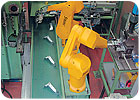
In 1998, Strong-Tie built a new European headquarters and manufacturing facility in Tamworth, England. The plant now employs approximately 120 workers operating a series of high- and low-volume production lines.
In its high-volume line, Strong-Tie produces connectors with the help of an automated transfer press, which forms the galvanized, coiled steel into finished product. In its low-volume lines, where the company typically produces batch sizes of 4,000 parts or less, a trio of operators manually feeds material and assembles the connectors, while a fourth operator performs packaging.
To increase the efficiency and profitability of its low-volume production, Strong-Tie installed a pair of RX90L six-axis robots from Stäubli Corp. (Duncan, SC). “We were interested in automating these manual operations to reduce labor and improve throughput,” says John Phipps, director of operations at Strong-Tie. “We had no experience of using robotics in this factory, so we consulted with Stäubli.”
Strong-Tie installed both of the robots in a single cell, with the machines positioned in such a way that they can each move product between stations and present the work correctly at each processing stage.
In operation, the first robot picks up a cut and profiled steel blank from an input conveyor and presents it to a press, which forms the connector’s main flange. The robot then transfers the connector to the second robot, which manipulates it during further possessing and deposits the finished product on the output conveyor. An operator inspects the finished connectors and packs them for shipping.
Installed in 2005, the two robots have already performed beyond expectations, with a single operator now handling what once required four separate workers. Strong-Tie, like many manufactures, requires a 2-year minimum payback period before it will even consider an investment. However, the robot cell achieved complete return on investment in less than a year.
Currently, the robots are programmed to produce about 100 different products, and they have the capacity to produce a lot more. Strong-Tie’s customers often request new connector sizes and configurations, often in small initial quantities. Because of their flexibility, the robots can easily adapt to these changing production needs. Overall, Strong-Tie estimates the robots have provided a 33 percent increase in productivity.
“The robots operate fast, accurately and reliably. We are now considering locating the robot cell at the end of our main press line and extending the robots’ sequence to include packing the product, which will bring additional savings,” Phipps says.
For more information on industrial robots, call 864-433-1980 or visitwww.staubli.com.